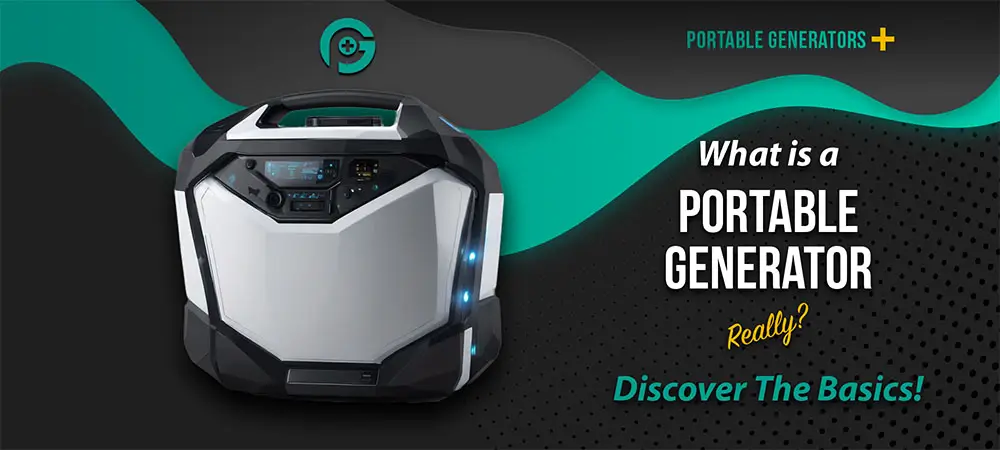Introduction
Imagine being able to have power wherever you go, even in the most remote places. With a portable generator, this becomes a reality. Portable generators are compact and versatile devices that provide electrical power on the go.
Whether you’re camping, working on a construction site, or experiencing a power outage at home, a portable generator can be a lifesaver. In this article, we will explore the fundamentals of a portable generator, shedding light on how it works, its various uses, and the benefits it offers.
By the end, you’ll have a clear understanding of why a portable generator is an essential tool for any situation where electricity is needed.
What is a Portable Generator?
A portable generator is a device that provides electrical power when there is no access to the grid or during power outages. It is designed to be transported easily and used in various locations. Whether you’re camping in the great outdoors or experiencing a blackout at home, a portable generator can be your reliable source of electricity.
Definition of a Portable Generator
A portable generator is a compact and mobile power generation unit that converts fuel into electricity. It typically consists of an engine, an alternator, a fuel tank, a control panel, a circuit breaker, a voltage regulator, an exhaust system, a muffler, and a spark arrestor. These components work together to generate electricity and power various appliances and devices.
Types of Portable Generators
There are two main types of portable generators: conventional and inverter. Conventional generators are more affordable and provide consistent power output. They are suitable for powering large appliances and tools.
On the other hand, inverter generators are quieter, more fuel-efficient, and provide clean power with less variation in voltage and frequency. They are ideal for sensitive electronics and devices such as laptops, smartphones, and TVs.

Components of a Portable Generator
To understand how a portable generator operates, it is essential to familiarize yourself with its various components.
Engine
The engine is the heart of a portable generator. It is responsible for converting the chemical energy from fuel combustion into mechanical energy. The engine’s power output determines the generator’s overall wattage capacity.
Alternator
The alternator is the component that converts the mechanical energy generated by the engine into electrical energy. It consists of a rotor and a stator, which work together to produce alternating current (AC).
Fuel Tank
The fuel tank stores the fuel required to power the generator. It can vary in size depending on the generator’s capacity and expected run time.
Control Panel
The control panel is where you can start and stop the generator, monitor fuel levels, and control various settings. It typically includes switches, buttons, and gauges for easy operation.
Circuit Breaker
The circuit breaker protects the generator and connected appliances from electrical overloads. It automatically shuts off the power if there is a surge or excessive current flow, preventing damage to the generator and potential electrical hazards.
Voltage Regulator
The voltage regulator ensures that the generated electricity has a stable voltage output. It prevents voltage fluctuations that could damage sensitive electronics or cause them to malfunction.
Exhaust System
The exhaust system is responsible for safely venting the exhaust gases produced during the combustion process. It typically includes a muffler and a spark arrestor.
Muffler
The muffler reduces engine noise by minimizing the sound waves produced during the exhaust process. It plays a crucial role in maintaining a quiet operation, especially for generators used in residential areas or during camping trips.
Spark Arrestor
The spark arrestor is a safety feature that prevents sparks from exiting the exhaust system. It reduces the risk of fire and makes the generator safer to use, particularly in areas where there may be dry vegetation or flammable materials.
How Does a Portable Generator Work?
Understanding the principle of operation and power generation process of a portable generator helps you grasp the mechanics behind its functionality.
Principle of Operation
A portable generator operates on the principle of electromagnetic induction. The engine drives the alternator, which consists of a rotor and a stator. As the rotor spins, it creates a rotating magnetic field that induces an electrical current in the stator windings. This current is then converted into usable electricity.
Power Generation Process
- Fuel is supplied to the engine, either through a direct fuel line or a fuel tank.
- The engine combusts the fuel, creating controlled explosions that generate mechanical energy.
- This mechanical energy is used to spin the rotor inside the alternator.
- The spinning rotor induces an electrical current in the stator windings, converting the mechanical energy into electrical energy.
- The electricity produced is then regulated by the voltage regulator to maintain a stable voltage output.
- The generated electricity is available for use through the outlets or power ports located on the control panel of the generator.
Benefits of Using a Portable Generator
Using a portable generator comes with numerous advantages that make it a valuable tool in various situations.
Convenience
A portable generator offers the convenience of having access to electricity wherever you go, whether it’s camping in remote locations, hosting outdoor events, or working on construction sites. You can bring power to areas where grid electricity is not available or practical.
Emergency Power Source
During power outages caused by severe weather, natural disasters, or other unforeseen circumstances, a portable generator can serve as a reliable emergency power source. It allows you to keep essential appliances running, such as refrigerators, freezers, heaters, and medical equipment.
Versatility
Portable generators come in various sizes and power capacities, allowing you to choose the right one for your specific needs. They can power a wide range of devices and appliances, from small electronics and lights to larger equipment and tools.
Ease of Use
Modern portable generators are designed with user-friendly features and controls, making them accessible to a wide range of users. They often have pull-start or electric start options, and their control panels provide clear instructions for operation.
Cost-Effective
In comparison to installing a backup power system or relying solely on batteries, a portable generator is a cost-effective solution. It offers a more affordable initial investment and allows you to select the appropriate generator size based on your power needs, saving you money on unnecessary capacity.
Choosing the Right Portable Generator

When selecting a portable generator, it’s crucial to consider your specific requirements and factors that will influence its performance.
Determine Power Needs
Start by identifying the essential appliances, tools, or devices you want to power with the generator. Calculate their cumulative wattage requirements to determine the minimum power capacity you need. Consider both the starting and running wattage of each device.
Consider Fuel Type
Portable generators usually run on gasoline, propane, diesel, or a combination of fuels. Each fuel type has its advantages and disadvantages, such as availability, cost, and storage requirements. Choose a generator that utilizes a fuel type that suits your preferences and needs.
Selecting the Right Size
Choose a generator with the appropriate power capacity to meet your requirements. Consider both the starting and running wattage of your appliances and ensure the generator can handle their peak loads without overloading.
Understanding Run Time
The run time of a portable generator refers to how long it can operate continuously on a full tank of fuel. It is essential to understand the run time and determine if it meets your needs. Look for generators with fuel-efficient engines and manageable run times to avoid frequent refueling.
Considering Noise Level
Generators can produce significant noise levels, which may be a concern, especially in residential areas or during camping trips. Look for generators with noise-reducing features or consider inverter generators known for their quiet operation.
Safety Features
Pay attention to the safety features included in the generator. Look for features like low-oil shutoff, circuit breakers, and automatic voltage regulation. These features help protect the generator and your appliances from damage.
How to Safely Operate a Portable Generator
Operating a portable generator safely is of utmost importance to prevent accidents, injuries, and damage.
Choosing the Right Location
Place the generator on a flat, stable surface away from flammable materials, water sources, and high-traffic areas. Ensure there is proper ventilation to prevent the buildup of harmful exhaust gases.
Fueling and Starting the Generator
Follow the manufacturer’s instructions for fueling the generator, avoiding overfilling and spilling. Start the generator according to the provided guidelines, typically by engaging the choke, turning on the fuel valve, and pulling the starter cord or activating the electric start.
Connecting the Appliances
Use heavy-duty extension cords to connect your appliances to the generator, ensuring they are rated for the required wattage. Avoid overloading the generator by carefully distributing the load among multiple circuits.
Maintenance and Storage
Regular maintenance is crucial to keep your generator running smoothly. Follow the manufacturer’s recommended maintenance schedule, which may include tasks such as oil changes, air filter cleaning or replacement, and spark plug inspection.
Preventing Carbon Monoxide Poisoning
Never operate a portable generator indoors, including inside garages, basements, or enclosed spaces. Generators emit carbon monoxide, which is a colorless, odorless gas that can be deadly. Always position the generator in a well-ventilated area to prevent the buildup of this dangerous gas.
Common Portable Generator Uses

Portable generators have a wide range of applications, making them versatile tools in various situations.
Camping and Outdoor Activities
When camping or participating in outdoor activities, a portable generator can provide power for lighting, cooking appliances, charging devices, and other necessities. It allows you to enjoy the comforts of home even in remote locations.
Powering Tools and Equipment
For construction sites, workshops, or outdoor projects, portable generators are commonly used to power tools, such as drills, saws, air compressors, and pumps. They enable work to continue even in areas without access to the grid.
Backup Power during Outages
During power outages caused by storms, natural disasters, or infrastructure issues, a portable generator can be a reliable backup power source. It keeps essential appliances running, allows you to charge electronics, and maintains comfort and safety until the grid power is restored.
RV or Boat Power Supply
Portable generators are often used to provide electricity for RVs and boats. They enable you to power appliances, air conditioning systems, and other electrical devices while on the road or out on the water.
Temporary Power for Construction Sites
Construction sites often require temporary power, and portable generators provide a convenient solution. They can power equipment, lighting systems, and tools needed for the project until a permanent power source is available.
Tips for Maintaining a Portable Generator
Proper maintenance is essential to ensure the longevity and reliable performance of your portable generator.
Regular Maintenance Schedule
Follow the manufacturer’s recommended maintenance schedule for your specific generator model. Regularly check the owner’s manual for guidelines on oil changes, filter replacements, and other routine tasks.
Cleaning and Inspecting Components
Keep the generator clean by removing dirt, debris, and any flammable materials from its exterior. Inspect the components regularly for signs of wear or damage and address any issues promptly.
Changing Oil and Filters
Regularly change the oil in your generator according to the manufacturer’s guidelines. This helps keep the engine’s internal components well-lubricated and prolongs its lifespan. Replace the air and fuel filters as recommended as well.
Checking Fuel and Spark Plug
Regularly inspect the fuel lines, ensuring they are free from leaks or damage. Check the fuel level before starting the generator. Additionally, inspect the spark plug for signs of wear or fouling and replace it if necessary.
Storing the Generator
If you won’t be using the generator for an extended period, properly store it to prevent damage and ensure its readiness when needed. Follow the manufacturer’s instructions for storage, including draining the fuel or adding a fuel stabilizer, and store it in a clean and dry location.
Portable Generator Safety Precautions
To ensure your safety and the safety of others, it is important to follow certain precautions when using a portable generator.

Keep Generator Dry
Always operate the generator on a dry surface and protect it from rain, snow, or other wet conditions. Moisture can damage the generator and increase the risk of electric shock.
Never Use Indoors
Do not operate the generator indoors, including garages, basements, or enclosed areas. Generators produce carbon monoxide, which is a silent and deadly gas. Only use the generator in well-ventilated outdoor areas.
Avoid Overloading the Generator
Understand the generator’s power capacity and the wattage requirements of your appliances. Do not exceed the generator’s maximum wattage, as overloading can damage the generator, appliances, and pose a safety hazard.
Use Proper Extension Cords
Use heavy-duty extension cords rated for the generator’s power output. Avoid using frayed or damaged cords, and make sure they are suitable for outdoor use. Keep cords away from water and ensure they are not a tripping hazard.
Turn Off Before Refueling
Always turn off the generator and allow it to cool before refueling. Gasoline and other fuels are highly flammable, and refueling a hot generator can cause a fire or explosion.
Do not Connect to Home Wiring
Avoid connecting the generator directly to your home’s electrical system unless you have a professionally installed transfer switch. Connecting the generator to home wiring incorrectly can cause back-feeding and pose a risk to utility workers and damage your generator.
Summary
Portable generators provide a practical and versatile solution for various power needs. Whether you’re seeking convenience during outdoor activities, preparing for emergencies, or powering tools in remote locations, understanding the basics of portable generators is essential.
By choosing the right generator, operating it safely, and following proper maintenance practices, you can ensure reliable power whenever and wherever you need it.
Thanks for reading.
Cheers!


